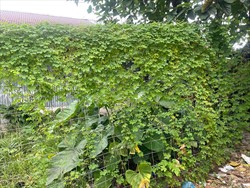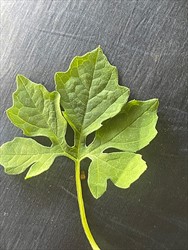Bitter gourd. It is also known as bitter melon, balsam apple, balsam pear, bitter cucumber, and more.
Pacific Pests, Pathogens, Weeds & Pesticides - Online edition
Pacific Pests, Pathogens, Weeds & Pesticides
Bitter gourd (548)
Momordica charantia. Note, Momordica charantia is like Momordica balsamina [common balsam apple (or pear)] but tends to have smaller fruit. According to Kew, Momorica balsamiona grows in the seasonally dry tropics. It is present in Australia. Both are members of the Cucurbitaceae.
Asia, Africa, North, South and Central America, the Caribbean, Oceania. It is present in Australia, American Samoa, Cook Islands, Federated States of Micronesia, Fiji, French Polynesia, Guam, Kiribati, Marshall Islands, Nauru, New Caledonia, Niue, Northern Mariana Islands, Palau, Papua New Guinea, Samoa, Solomon Islands, Tonga, and Vanuatu. It is naturalised in most tropical and subtropical regions. It is probably native to Africa, Asia, and Australia, and was domesticated in India and southern China. Domesticated forms occur in North, South and Central America, the Caribbean, and Pacific islands.
An aggressive, fast-growing, invasive vine of tropical and subtropical areas. Often smothering competitors. Common on fences and walls alongside roads (Photo 1), along creeks and rivers, coastal areas, on waste ground, other disturbed sites, as well as native species on the fringes of rainforests. Also, a weed of many horticultural, orchard and plantation crops,
There are several characteristics which account for its invasive weediness: it tolerates a wide range of rainfall (500 to 4000 mm annually), soil pH from 4.3 to 8.7), displays rapid growth, a very short time between germination and flowering (30 days), and has tenacious tendrils that latch onto supports, coiling and acting like a spring to raise the stem. It is found from sea level to 1000 masl.
Slender stems, slightly hairy or hairless, slightly ridged, growing (sprawling) to about 2-3 m. Leaves alternate along the stem, on 3-5 cm long leaf stalks, with leaf blades up to 15 cm across, deeply separated into 5-7 lobes, each with irregularly toothed margins (Photos 2&6). Unbranched tendrils arise from the axils of the leaves. Flowers (male and female on the same plant), yellow, borne singly from the axils of upper leaves, on 2-10 cm long stalks, each with five petals (Photo 3). The fruit is ridged and looks like a warty gourd, usually egg-shaped, 2-5 cm long, green, turning to orange-yellow when ripe (Photo 4). At maturity, the fruit splits into three irregular parts which curl back to show the edible red flesh around the many black seeds (Photos 5&6). The fruit has a strong unpleasant smell when crushed.
Bitter melon spreads as seeds and vegetatively by underground stems. The red flesh around the seeds is attractive to birds and other animals. Spread can also occur through the contamination of machinery by stem pieces. Spread over longer distances is from sales of seed and plants nationally and internationally.
It has been reported invasive in Cook Islands, Guam, Hawaii and many other Pacific island countries, Brazil and the Caribbean, but few details of impact are reported. However, in Queensland, it is a problem in sugarcane: in the first 3 months it may smother all growth, and at all stages, but particularly towards harvest, it climbs over the crop and binds stalks together, reducing sugar content and making harvesting difficult. In Papua New Guinea, it is said to be a weed in pastures making then unpalatable to stock. The fruits of bitter gourd are a host of the melon fly, Zeugodacus cucurbitae, a serious pest of crops in the Cucurbitaceae (see Fact Sheet no. 505).
A vegetable widely grown for its fruits, which are among the most bitter of all, in Asia, East Africa, India and South America. It is a component of stir-fries, curries, soups and pickles. For a long time, used in China, India (in Ayurvedic medicine) to control blood glucose and as a treatment for diabetes. Other medicinal uses include treatment for stomach conditions, ulcers, respiratory diseases, rheumatism, cancers, and more. In Papua New Guinea, it is used as a ground cover in cocoa, but care must be taken to prevent it climbing over the trees.
BIOSECURITY
The risk of introduction of Momordica charantia is very high. This species is a fast-growing vine which has been widely introduced for use as a vegetable, in traditional medicines, and as an ornamental. It has escaped from cultivation in many countries, naturalised, and become a serious threat to native plant, and crops. The ease of access to seeds via the Internet only adds to the likelihood of this species invading and colonising new habitats.
BIOLOGICAL CONTROL
Not a method recommended for Momordica charantia.
CULTURAL CONTROL
Physical & Mechanical:
- Hand-pulling isolated plants or small infestations is possible, but make sure all stem and root fragments are collected and burnt, otherwise those remaining will regrow.
- Cut plants at soil level, but this is a labour-intensive practice as it is likely to need repeating several times to achieve control as the roots will regrow from the taproot.
CHEMICAL CONTROL
In Queensland, Australia, fluroxypyr is registered for use in sugarcane on plants up to 100 mm high. Also, in Queensland, 2,4-D and fluroxypyr can be used under permit in non-agricultural areas - bushland, native forests, roadsides, wastelands, and dunes of coastal areas. In Federated States of Micronesia, triclopyr and glyphosate are used.
--------------------
Note, EU approval to use glyphosate ended in December 2022, but has been extended by one year to 15 December 2023.
____________________
When using a pesticide, always wear protective clothing and follow the instructions on the product label, such as dosage, timing of application, and pre-harvest interval. Recommendations will vary with the crop and system of cultivation. Expert advice on the most appropriate herbicides to use should always be sought from local agricultural authorities.
AUTHOR Konrad Englberger & Grahame Jackson
Information from CABI (2019) Momordica charantia (bitter gourd). Crop Protection Compendium. (https://www.cabidigitallibrary.org/doi/10.1079/cabicompendium.34678); and Momordica charantia L., Curcubitaceae (2013) Pacific Island Ecosystems at Risk (PIER). (http://www.hear.org/pier/species/momordica_charantia.htm); and Balsam pear Bitter melon, Momordica charantia (2019) The State of Queensland, Department of Agriculture and Fisheries. Queensland Government. (https://www.daf.qld.gov.au/__data/assets/pdf_file/0011/69491/balsam-pear.pdf); and Brisbane City Council (Undated) Bitter Melon (Momordica charantia). (https://weeds.brisbane.qld.gov.au/weeds/bitter-melon); and from Momordica balsamina L. Royal Botanic Gardens Kew. Plants of the World Online. (https://powo.science.kew.org/taxon/urn:lsid:ipni.org:names:293397-1). Photo 3 Ansel Oommen, Bugwood.org. Photo 4 William M. Ciesla, Forest Health Management International, Bugwood.org.
Produced with support from the Australian Centre for International Agricultural Research under project HORT/2016/185: Responding to emerging pest and disease threats to horticulture in the Pacific islands, implemented by the University of Queensland and the Secretariat of the Pacific.









